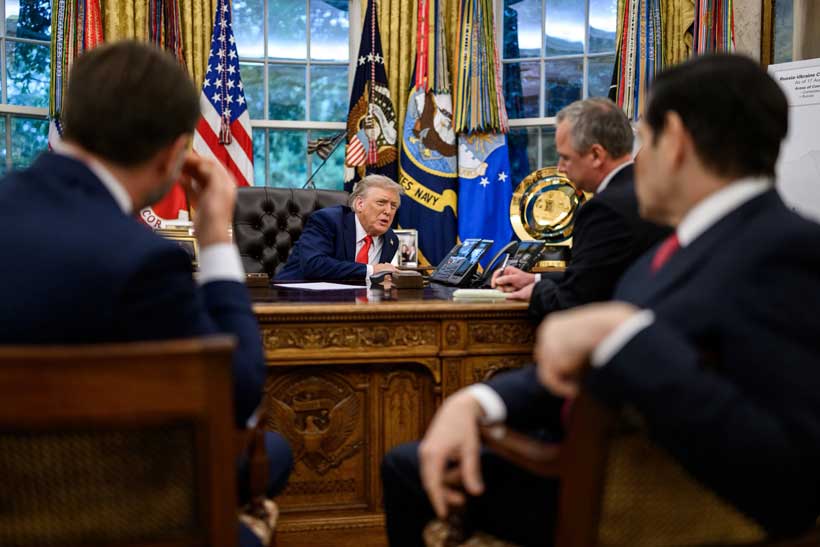In a span of a week, global politics had gotten some big headlines. Last Friday, Putin and Trump met in Alaska. The anticipated summit was the talk of the world for quite a while. Speculations to determination, the summit was an icebreaking summit for US and Russian relations. Especially the way President Donald Trump was dealing with Putin with threats and showing a little turn towards a hard line against Putin; however, that hard line again turned into “Brozone” in a three-hour meeting. Initially, it was meant to happen for seven hours. The meeting happened to end the war in Ukraine. After the meeting, nevertheless, there was no peace deal and no commitment. Trump deliberately passed the ball into Ukraine and Europe’s court.
Fast forward to Monday, Ukrainian president Volodymyr Zelensky, with his European counterparts, arrived at the White House. Five European leaders and the secretary general of NATO, along with European Commission leaders, were the participants in this summit. What was the result this time? Well, unlike the last time, when Trump hosted Zelensky in the White House back in February, this time, Zelensky wasn’t bashed for any reason. The meeting was held with all the big names without any disruption, and European leaders knew just the weapon to use against Trump to keep Trump on their side: the art of diplomacy through “flattery.” Still, there was no peace deal or anything. The European leaders thought this time they might sway Trump to go harsh against Putin, which ultimately failed.
Trump, from the very beginning, was determined about some parts in the deal. Ukraine won’t be taken into NATO, and Ukraine must forget about Crimea, which he sees as a fault of the Obama administration. Steve Witkoff, Trump’s appointed special envoy in the Middle East, who basically arrives in every conflicting part of the world as a peace-bringer as Trump’s ambassador, mentioned a part that’s now a cornerstone of the security agenda. Witkoff mentioned “something like NATO’s Article 5.” NATO Article 5 states that an armed attack against one member is considered an attack against all members, obligating each ally to take necessary action, including armed force, to assist the attacked party and restore security. It’s a profound part of NATO and what makes this military alliance different from every other alliance that’s out there. In the Alaska summit, Putin has agreed on some kind of “robust security arrangements” to secure the peace deal. So basically, Ukraine might secure its security by not joining NATO; however, there’s a catch. When Witkoff said something like “Article 5,” does it necessarily mean they are going to implement Article 5?
Here the debate comes. Something like Article 5 and implementing Article 5 don’t mean the same thing. And Witkoff wants European contribution to this security to play a bigger role. As Trump mostly follows a “unilateralist policy,” he doesn’t want to be the firsthand guarantor in the security arrangements. Whereas, the European leaders want to see Donald Trump playing a bigger role in this context. The EU already took a big initiative to spend on a military budget higher than ever, reaching 5% of the whole budget for every country before 2031. Back in March, the EU proposed “Sky Shield” for Ukraine. The European Sky Shield for Ukraine is a proposed European-led air protection strategy designed to defend western and central Ukraine from Russian missile and drone attacks during the Russian invasion of Ukraine. “Sky Shield” aims to protect critical infrastructure, including Ukraine’s operational nuclear power plants, major cities like Kyiv, Lviv, and Odessa, and vital economic corridors. The plan would not include operations in the eastern parts of Ukraine; however, it hasn’t materialized yet.
Trump saw the Russia-Ukraine war as Biden’s war, which he never wanted to drag on in the first place. Before being elected, he boasted about ending the war in Ukraine. Though, he couldn’t stop the war after seven months. This is quite a stigma on his “Peacemaker” appearance. Trump was seen to have fallen out with Putin, even tariffing a major ally, India, for buying Russian crude oil. From almost falling out, the Alaska summit again showed Trump’s humility with Vladimir Putin.
European leaders couldn’t budge Trump from his unwillingness to get involved in the Russia and Ukraine war. There was a motion to send a peacekeeping force to Ukraine from the UK and France. But they couldn’t find their other allies beside them. Germany, Italy, and even Poland rejected the idea of sending their troops to Ukraine, not even as peacekeepers. The US isn’t backing up Ukraine with military and financial aid, likewise the Biden era. Europe has already surpassed the US’s financial aid to Ukraine and is soon going to surpass it in the military sector. In any of the scenarios, there is no sign of a security deal or any comprehensive peace treaty between Russia and Ukraine. And every week, Russia is taking up more land in the Donbass region. It already occupies 20% of the land in Ukraine, and there is no sign that they want to give the land back to Ukraine. Experts are rigid in the idea that Putin won’t give the lands back it occupied. Neither will Ukraine accept a Russian-compelling peace treaty. So the stalemate is firm.
Trump has announced there will be a trilateral summit with the Ukrainian president and Russian president. As the security guarantee fades away and the Russian army occupies more lands every week, the war looks far away from ending. A treaty like the 1994 “Budapest Memorandum” won’t be accepted by the Ukrainian side; likewise, the Minsk agreement won’t be accepted by Ukraine and the EU. The demand is something solid and binding. Some are talking about a “Reassurance Force” that will secure Ukraine and Europe too, or an “Ironclad” agreement like the US-Japan and the US-South Korea security mechanisms. Till the next summit, the world awaits to see a peace deal being activated at the border of Europe.
